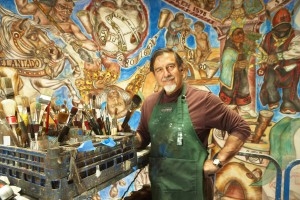North America’s Largest Concave Fresco Is In NM, About Latinos
 Albuquerque, New Mexico — Walking into the Torreon at the National Hispanic Cultural Center (NHCC) in here is an unexpected, yet awe inspiring experience.
Albuquerque, New Mexico — Walking into the Torreon at the National Hispanic Cultural Center (NHCC) in here is an unexpected, yet awe inspiring experience.
From your first steps into the tube-shaped building, you find yourself unable to focus on anything in particular, as any of the thousands of colorful details on the fresco mural covering the entire inside of the structure demand your attention. Whether it’s the matachines or the conquistadors or the scholars, babies, agriculture, immigrants, cave paintings, animals or mythology, somehow, you think that if you stare at it long enough, you might be able to take it in all at once.
“When I walked in here and they said, ‘This is the wall you can use, paint whatever you want.’ I thought I was a candy store,” said the mural’s artist Frederico Vigil, a painter and fresco artist who is well known in the Albuquerque–Santa Fe area. This fresco is the largest concave fresco in North America, and it was painted by a Latino and about Latinos.
A native of this region, Vigil told NewsTaco that he had but one idea in mind in 2002 when he first began work on the fresco at the request of the NHCC.
“I thought about mestizaje — what makes us who we are,” Vigil told us, And also shared an anecdote to this end. “The Mexican Museum of Art in Chicago, I tried to get in there, but I wasn’t ‘Mexican enough.’ So are we too Mexican? Are we too black? Are we too Hispanic? Are we too Anglo? We are mixed. So anybody who says ‘You are not Mexican enough, you can’y show my Museum‘ — what do you mean, I’m from New Mexico, how much more Mexican can you be?”
And the mural itself does a pretty good job of tackling the subject. Vigil started researching the mural in 2002 with the help of a team of five scholars, while he began the initial plaster coats of the fresco; one must apply five coats before getting to this stage whether rough draft of the painting may be applied. Final approval for the design took two years and seven months and the mural was completely finished in February of 2011.
One might wonder, what took so long? But as was alluded to earlier, not only the forms, but the sheer scale of this particular fresco is pretty awesome. Contained in it, are horses whose faces are as tall as your average NewsTaco editor; other figures range from 5 to 9 to 12 feet tall. This only makes the process Vigil utilized to create this work of art all the more interesting.
Essentially, Vigil divided the 4,000 square–foot fresco into quadrants, or slices of pie as he told us, and divided each quadrant with a painted column and into each quadrant painted a particular homage to Latino cultural heritage in the United States. The four quadrants are broken down into: Iberios (Spain), Mesoamerica (Azteca, Inca, Maya, etc.), Southwest Pueblos/Camino Real and U.S./Nosotros. Each quadrant tells the story with historical figures, action sequences, symbols and mythical representations about how, say, the Mayas’ use of wheels for toys is interrelated to their use for transportation in Europe. Or, as Vigil said, “We are all the same.”
There is so much to see that a visitor surely must either go more than once, or spend a good chunk of time trying to cull as much as possible in one visit. Did you see the oldest cave painting from Alta Mira? What about the ant that represents Quetzalcoatl? Did you see the Jewish philosopher? Vigil worked with the aforementioned scholars to ensure that each image on the fresco was factual, and now that the mural is completed, he’s not looking to start any new projects more grants, but hopes that visitors enjoy the message of mestizaje for one principal reason.
“I think what we’re showing here is how interrelated [we] are,” he said, standing at the center of the tower, looking at his work. It eliminates a lot of the discriminations we have, I have it, everybody has it, that’s the way we grew up. I guess what I’m saying here, is that we are all interrelated.”
[Photos By María Elena Álvarez]
